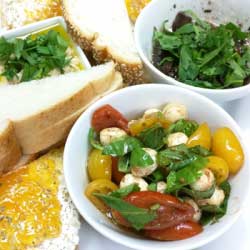How To Design a Weekly Menu

How to design a weekly menu is actually really simple once you understand how to do it. Writing a menu is much like creating a successful household budget. You need to take into account every meal and snack that you are going to eat throughout the entire week. The more thorough you are in the designing of the menu, the more successful you will be.
To keep this section from getting too long, I am going to teach you the simplified version that I use. This method is one that I have developed and use. It uses redundant ingredients to help you save money and not waste food. For me, there is no worse feeling than throwing food away that has gone bad from neglect or dis-use. So, let’s learn how to design a weekly menu.
1. Brainstorm 10 dinner meals
10 is not necessarily the rule. What I am trying to convey is that you should brainstorm lots of different ideas so that you can look for opportunities to use common ingredients. Using common ingredients helps save money and not waste food. In the beginning, it is a prudent exercise to come up with as many ideas as possible to exercise the newly learned culinary skills that you have acquired from this book. The more you practice, the better and quicker you become at this task.
2. List the ingredients for each meal
Listing out the individual ingredients allows you to find the common ingredients and have greater control over your meals. Here, listing out the ingredients also helps you memorize recipes and learn the basic commonalities of different types of dishes.
3. Look for common ingredients
Finding the common ingredients saves you time and money. It allows you to make better decisions before you go to the grocery store.
4. Remove the meals without common ingredients
Doing this saves money, time, and your energy. During cancer treatment, using common ingredients makes it easier to prepare your ingredients in advance. This helps make cooking your meals a breeze. For example, if you know that you have 3 recipes that use red onion, you can slice up all the onions you need for the week and place them in a sealed container in the refrigerator to use as you need them. This is a technique that is pulled directly from the restaurant industry. We pre-make, pre-cook, and pre-cut all of the ingredients that go into every appetizer, entrée, or side. We do this because having to cut each ingredient by hand or mix each sauce on the line, as it is ordered, would take too long. Customers would be irate if they had to wait 45 minutes for French toast instead of 10.
5. List breakfast meals and their ingredients
Listing out your meals makes it easier to pick and choose on the fly. Listing out the ingredients for breakfast allows you to find common ingredients from the dinner menu or breakfast menu.
6. Purchase sufficient ingredient quantities.
Not purchasing a sufficient quantity of an ingredient can be frustrating. This can lead to multiple trips to the grocery store, which is a waste of your valuable time. Make certain to account for every instance and every quantity of ingredient that each recipe calls for.
7. Buy all of the ingredients that are on the grocery list.
Buying all of your ingredients at once saves time and money. When you are acting as a caregiver, there are so many activities that take up your time. Something as simple as going to the grocery store can become a massive chore. Save yourself the headache and get it all done the first time around by creating a grocery list.
As you can see learning how to design a weekly menu is actually a really easy task once you have a frame of conceptual reference to put the thought process into. What I have taught you is simply the thought process and methodology that I use when preparing a menu for the week. Give it a try for a few weeks and then you will be able to develop your own techniques that work best for you and your family.
When we are planning our meals, we need to be calorie conscious and to include of all the nutrients that we talked about in the macro nutrient article. Choose well rounded meals that include all of the nutrient categories. That is where meal planning and nutrition work hand in hand to make you happy and healthier.
Taking control of your food is taking control of your grocery budget. Taking control of your grocery budget allows you take back control a part of your life that cancer will normally send into a tail spin. When you are in control, you are empowered to make better and more effective choices in your life. This leads to a better quality of life overall.